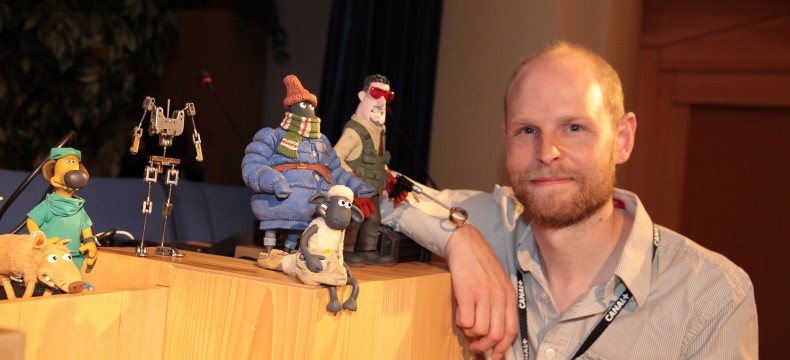2015 Conference Summaries

Animating without Dialogue: The Animation in the Feature 'Shaun the Sheep Movie'
Contents
The spirit of a film about Shaun goes back to the 1980s when Aardman Animations hired Nick Park to help direct the "Wallace and Gromit" shorts. Shaun made his debut in 1995 in the third episode, "A Close Shave", where he ends up "shorn". William Becher, Lead Animator at Aardman takes us behind the scenes to show how his work takes shape to give a clearer understanding of how to handle puppets in stop motion.
Soon after Shaun's first screen appearance in 1995, the little sheep initiated his own television series, which was first broadcast in 2007. Since then, Richard Starzack has been developing Nick Park's character to become a star in his own right. Shaun the Sheep now has a total of 150 episodes that are aired all over the world. 21 episodes were also produced for the London Olympic Games as well as mini-episodes for the Nintendo DS video game.
The Shaun the Sheep feature was a project that took two years to complete: one year to write the story and another to finish the animation which is fast compared to the studio's normal standards. A four-person team created close on 80,000 drawings, assembling them together to serve as a template for the film. Script and production required a dozen people, and once the scenario was done the creative team began to take things into their own hands. Technicians, carpenters and craftsmen got together and created Shaun's world. As nothing corresponding to his dimensions could be commercially bought, all the objects and props were custom made.
The film was shot in the suburbs of Bristol and the sets were inspired by the buildings of Bristol and London and reproduced for the miniature model city. Residents of Bristol may even recognize them one day on screen. The crews at Aardman are used to working together down to the smallest detail. Everything is built like a puzzle that can be taken apart and then reassembled for other shots.

Shaun is a very simple character with his expressions coming from his eyes, eyelids and ears. A special material was treated to give his fleece a natural look and clay was predominantly used as the project is very visual. Animators used fifteen varying mouth shapes for each character to express a wide variety of sounds and a large range of emotions.
Filming multiple scenes simultaneously also needs many versions of the same characters. For example, no less than 394 puppets were made that required one year of work and thirty models of Shaun were used.
To create the characters in silicone, modellers referred to 2D drawings, sometimes done by Richard Starzack himself. While Wallace and Gromit had armatures that took a lot of time to sculpt and shape, Shaun has an articulated skeleton made from a generic metal. However, they had to find a material that was hard yet flexible enough for characters whose heads would be frequently removed. Each body part was cast in a silicone mould, then a layer of clay was applied before being baked in the oven. All the joints had to be cleaned and painted by hand for a better look. Finally, each character was positioned to coordinate all the elements of the scene.
The animator must be on set to manipulate a character, for example in a bus or a hospital. They must also use rigging for characters, find ways for getting into the sets and the ideal place from where to manipulate the puppets. Each character is designed with a slit in its back to handle it in the air.
In stop motion, the director talks with the animator at the early stage of each shot, then it takes a week before he can see the result. There needs to be a lot of mutual confidence and each shot comes with its stress levels that are equally shared. The director's goal must be achieved first time around, so communication is very important. Missing a shot means shooting it again and waiting another week for the visual. The animator's workplace is the set; he becomes the character and has to think about where that character should be placed.
Question: You've worked on films with and without dialogue. How does your work differ as far as the characters' expressions are concerned?
• W.B.: As animators, we use dialogue to show off the acting. The director gives very detailed instructions and the animators use dialogue to reinforce the key points, taking into account the dialogue and body movements. For Shaun, we particularly worked on the expressions and poses. His eyes are the only features we have to change his facial expression. There is also a lot of work on the positioning of his head and shoulders.
Question: You have a direct return on a screen. If something's not working, can you go back?
• W.B.: Yes. Stop motion is linear so we can go back and delete a session, but we don't have any keyframes like you do in 2D. We must create each movement physically one after the other. If we move away from a precise starting point, it is difficult to get back. We can erase images, but it's hard to make identical reproductions.
Question: How many animators worked on the film?
• W.B.: We began the film with two animators and ended up with 18 working simultaneously. An animator may be working on a scene and another can come along and work with another camera from a different angle. Each animator tries to produce three seconds of animation a day.
Question: How do you simulate the subtle movements of Shaun's fleece that make him look so real?
• W.B.: Each puppet has a place where the animator can put his fingers. He moves it, then takes a photo and goes on to the next movement.
Question: Is there any post production?
• W.B.: Yes. The sky that you see is painted with Photoshop. We also have a theatrical background but that limits the number of clouds and colours. Water, steam and fire are also difficult to create in stop motion.
Question: What is the life span of each puppet?
• W.B.: We create them to last as long as possible, but they do get dirty and have to be washed with wipes. Mouth shapes get distorted and sometimes must be remade, but everything is designed to be removable and replaceable as some animators are rougher in the way they work than others.
Drafted by Alain Andrieux, ITZACOM, France
The Annecy 2015 Conference Summaries are produced with the support of:

![]()
Conferences organised by CITIA 
under the editorial direction of René Broca and Christian Jacquemart

